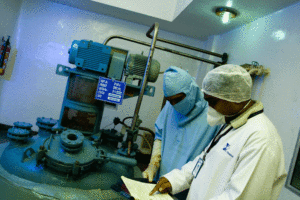While linear drug scale-up sounds great on paper, the reality is usually much different. In fact, scaling up an API can be challenging even under the best circumstances.
In fact, most scale-up challenges arise from the non-linear nature of shifting from the bench to the manufacturing plant. Not only do chemical reactions function differently at larger scales, but the environmental health & safety (EHS) issues can be enormous. How enormous? Well, just how do you safely store – and eventually dispose of millions of gallons of potentially highly-toxic chemicals each day?
Here are 5 Common Challenges in API Scale-up our scientists frequently confront:
- Reactions
In Unit Processes, reactions may poorly impact product selectivity during scale up if they are not properly understood at the lab scale. This can result in an increase in impurities – impacting both yield and quality.A thorough working knowledge of the chemical reactions includes the effects of scale-dependent factors (such as mixing, mass transfer and heat transfer). Using simulation software (for example, Dynochem or Visimix), the effects of mass, heat transfer and mixing changes can be predicted at larger scales.Design of Experiment (DoE) should be followed at lab scale to develop a robust process, including the time, temperature and mixing scale criticalities. This exercise will provide adequate Design Space for variability, and avoid surprises during scale up & technology transfer. The lab process validation & qualification to be done in the manufacturing plant should mimic the conditions at the lab scale. For example, switching to cylindrical reactors during manufacturing may mean the slower addition of reagents, a slower rate of heat increase and decrease and more.
- Safety Data Generation
Runaway reactions are a challenge during scale-up. Generating safety data at lab scale can potentially help in designing the hardware for pilot or commercial scale batches – leading to inherently safer process technology. This typically involves Reactions hazards and Thermal hazards studies. These are performed using Reactor calorimeters, Thermal Screening units (TSu), or Rapid Screening Devices (RSD) to monitor: - Reaction heat
- Reaction initiation temp
- Adiabatic temp rise
- Gas evolution rate
- Crystallization
Crystallization often causes problems if the Critical Process Parameters and their impacts on Critical Quality Attributes (CQA) have not been adequately studied. Crystallization can negatively impact solubility and dissolution rates. Changes in crystal habit (the external structure) or the crystal form (polymorphism – in which the internal arrangement of atoms is different) can have wider impacts on ease of filtration, washing and drying.These changes, in turn, can impact the Particle Size Distribution and bulk density, porosity, surface area or polymorph-pseudo polymorph (solvates/hydrates) to ultimately affect the formulated product’s drug activity. Process Analytical Techniques (PAT) can be used during lab development to understand the impact of process parameters on physicochemical properties.
- Drying
Drying APIs at larger scales – much as with crystallization – can be complicated. It is common to use an NIR probe to perform an on-line moisture checks. Residual solvents are a frequently-encountered problem during drying, and they are mainly the result of the crystallization process. When crystallization solvent is trapped in the lattice, it is difficult to remove it to a level that meets solvent limits during drying. Crystallization process parameters should be studied at the lab scale, including the super saturation driving force and its impact of residual solvent.
- Particle Size
An APIs’ particle size has become increasingly important – down to the micron level. Equally as important, however, is the Particle Size Distribution (PSD) – essentially, how wide the range of particle sizes in a given sample. Common size reduction techniques to meet today’s small, tightly-banded distributions include multi-milling, micronization or other size reduction (or sometimes enlargement) techniques & systems.Where particle size matters (and when doesn’t it?) Particle Engineering studies should be performed for both drying and crystallization using focused beam reflectance measurement (FBRM) and particle vision and measurement (PVM) probes to understand the impact of process parameters on target particle size and shape distribution.
Determining the proper parameters for API scale-up can be difficult. Using QbD and DoE approaches, API manufacturers and CDMOs can reduce unanticipated challenges by developing deep process knowledge at lab scale – which aids in transfer to scale-up.











